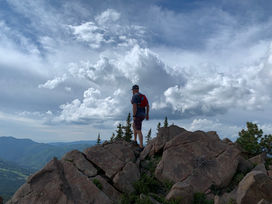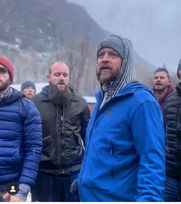Transitioning Past Grief
- Tony Pizza

- Jun 23, 2022
- 5 min read
Updated: Jul 22, 2022
One of the challenges to outdoor rock climbing is finding small ledges, cracks, outcrops, and irregularities in the rock for fingers and toes to gain traction or purchase. The smaller the purchase of these features, the greater the necessary skill and strength required to make upward progress.
So what does this have to do with grief?
This dance between climber and wall reminds me of my recent experience of making seemingly impossible progress through grief as a previous relationship of mine came to an end.

My slow progress through grief came as a bit of a shock. Being married three times, I have experience with these transitions. Though my most recent partner reached a depth none of my marriages had reached, I still felt like I had the necessary tools to move on. I can almost hear the universe still laughing at me saying, “Oh you sweet, innocent human – Not so fast.”
Though I had plenty of experience moving on when I thought the relationship had run its course, I was very inexperienced when it was someone else’s choice to end things.
Getting over that situation has felt like trying to rock climb 12-foot panels of glass. At times, it’s felt paralyzing, defeating, and so slippery, progress has felt non-existent. It brought up attachments I naively or arrogantly didn’t think I had. It also seemed to reveal every insecurity and shadow.
To make moving on a little more challenging, I decided to avoid a previous practice that helped me move on in the short term, but carry detrimental baggage in the long term. I call my previous practice “lily-padding.” Lily-padding is jumping from one situation to the next, often using the uplifting feeling of being validated by another human. This might seem like it helps to speed up the recovery process, but bypasses much-needed processing leaves many landmines of unresolved issues that either need more extensive future work, or derail relationships.
So this time, I decided to spend a lot of time with myself, getting curious about the painful edges I was encountering, and paying special attention to the discomfort of being alone. This seemed to make moving past my previous relationship all the more challenging. The wall was already slippery, and now my hands were sweaty and I didn't have the right shoes.
I’ve read many books on the power of one-degree changes over time. Martha Beck’s book “The Way of Integrity” speaks to this eloquently. Where I want my integrity and life path has been clear to me for quite some time. This, however, has not made accepting the “death” of a relationship, nor the ability to make progress much easier. In fact, I felt more divided than ever.
Half of me knew the benefits of moving on. The other half was death gripping. The bridge between the two felt like it had burned down. The sensation reminded me of a common occurrence I experience while meditating.
I’ve sat in meditation long enough to have a leg go numb. When I want to stand up, I know what I want my leg to do. I know why they're not able to respond. That knowledge doesn’t help the leg muscles get that message any faster. It takes changing my posture so that blood can start to flow again. So how do you shift position? For months, this had been a key I had yet to unlock. Four days ago, something shifted.
Here’s the process I took myself through:
Recognize the dominant emotion.
Ask what the emotion is teaching me.
Graduating the immature emotion into its mature form.
The credit for this practice goes first and foremost to Kevin Walton, a leader of Sacred Sons and the mastermind of a program known as Conscience Creatorhood. My brothers Rick Rosno and Joe Speredon both reminded me of this concept. The Way of Integrity by Martha Beck inspired me to center myself. The rest was up to me in allowing the practice to unfold.
Here’s what the process looked like for me in practice.
• Recognize the dominant emotion.
For me, this was sadness. Songs, pictures, social media posts, dreams, and memories would come in waves. Each time, tears would flow easily and I’d feel sadness directly in my chest and I could witness it bubble up to my throat.
• What is the emotion teaching me?
The emotion of sadness was teaching me that I had immense value in the relationship with my former partner. It was (and still is) very sacred to me. I was able to admit that it was the first time I’d felt that depth of love. The emotion was teaching me how valuable a deep love like that is, by showing me how painful it was to go without it. These are things I vaguely knew, but hadn’t synthesized into that precise understanding. I was grieving the loss of my partner because it was that valuable to me. Unlike past relationships, the value hadn’t been tarnished one bit even after I’d moved out and we stopped speaking to one another.
• Graduating the emotion into its mature form.
This is where Kevin Walton’s ideas really came into play for me. He had spoken about emotions being on a spectrum when he delivered a few lectures at the Sacred Sons event. It was Joe and Rick who reminded me of this. Sadness is the immature emotion. As sadness and its accompanying lessons get processed, the emotion matures into gratitude.
-Identifying the emotion was the equivalent of awareness.
-Identifying the lesson became a form of acceptance.
-The third step is where the shift took place for me.
Taking inventory of my gratitude in the relationship was no easy task. It was foreign and uncomfortable to shift out of my victim stance. That position felt safe. Allowing the experience to be the teacher allowed me to shift into an empowered dynamic.
This was the part I was not accepting. Victimhood allowed me to feel justified in my sadness, but it also kept me there, reliving it over and over like Prometheus experienced when he was damned to have his innards perpetually eaten by crows as a consequence for giving man the gift of fire in Greek mythology.
Here’s a sample of my gratitude inventory:
Feeling fully accepted in my imperfect body.
For all the adventures.
For the all the shared and new music woven into the relationship.
For her helping me rediscover a love for running.
Feeling and receiving unconditional love.
Introduction to the spiritual community.
Learning about my sexual edges and desires.
Learning to cook delicious food and the value of meal prepping.
Experiencing creamy wheat and pumpkin rolls.
Learning about love languages.
Learning how I don’t always fight fair in an argument.
Witnessing compassionate parenting.
Learning what deep heart break looks like.
A love for finding omens.
Learning that how clothing fits tells more about health than a scale.
Even in the break up phase, I’ve got so much to be grateful for.
I’m grateful for the silence container and how that showed me my shadows and edges.
I’m grateful for how its shown light on my misaligned masculine and has encouraged me to find tools to grow.
I’m grateful for the opportunity it’s given me to take accountability.
I’m grateful for recognizing my tendency to sugar coat and idealize things, and to acknowledge that I’m not the only factor in a relationship’s dissolution.
I’m grateful for discomfort that has pushed me in every direction.
Writing this list wasn’t easy. It brought up emotions throughout the process, namely sadness. But with each acknowledgement, and each pause when the emotion felt it was reaching the brim, the knot in my chest loosened. The cracks and small ledges became clearer. I began to find purchase again in a pit that felt I was doomed to linger in for the foreseeable future.
My hope is that this can help another soul find an effective way to climb out of the daunting hole of sadness and grief.



















Your inventory is well thought out. Helpful for me in many ways. Wrong shoes. Love it.